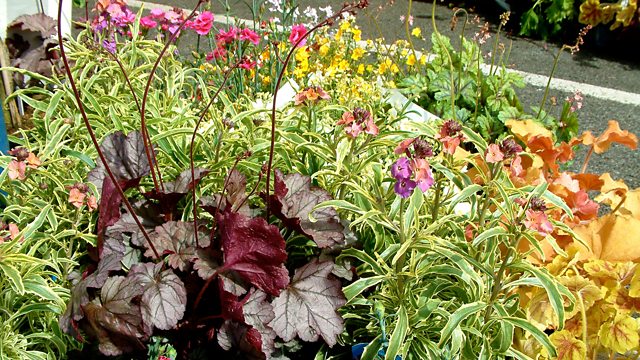Whitehaven, Cumbria
Eric Robson hosts the horticultural panel programme from the Whitehaven Festival, Cumbria. Answering the audience questions are Bob Flowerdew, Bunny Guinness and Christine Walkden.
Eric Robson hosts the horticultural panel programme from the Whitehaven Festival, Cumbria. Bob Flowerdew, Bunny Guinness and Christine Walkden answer questions from the audience.
Produced by Howard Shannon
Assistant Producer: Darby Dorras
A Somethin' Else Production for 主播大秀 Radio 4
This week's questions and answers:
Q: Are Brandling worms doing any damage to my garden?
A: No. They are fantastically good for your garden! They digest leaf-litter and increase the fertility of the soil.
Q: What would the panel suggest for a small, north-facing garden measuring 7 meters by 5 meters? I am looking for all year round colour.
A: A Canna iridiflora would do well. You could also try planting flowering annuals in tall containers.
Q: When and how should I take cuttings from my Clematis?
A: Start taking cuttings in June and keep on trying until September. Try slitting the cutting and scraping the bark off as this will encourage root growth. You could also try to train one of the plant's young shoots through the hole in a plastic pot, damage the bark, then fill the pot with compost, use a couple of clothes pegs to hold it in place and then when it has rooted cut it off and take it away to plant.
Q: I have two different species of espalier apple trees, planted six or seven years ago against a northwest-facing wall. One produces loads of fruit, but there is no plant growth, the other grows prolifically but does not fruit. How can I persuade them to share their talents more equally?
A: Espalier apple trees should remain fairly small and produce a lot of fruit. The depth that the trees were planted and the amount of moisture they receive would affect the growth rate. Bramley apple trees are known to grow more vigorously than any other apple variety. Make sure you prune back hard in October and give the tree that is growing a good amount of potash (combined with wood ash) and this will encourage the tree to flower. The smaller tree may also be on a very small dwarfing rootstock, and this might be what is inhibiting the growth. You could also try a summer prune in July and this will encourage more flower buds. You could try moving the trees to a sunnier wall.
Q: What adverse affects will a mild winter and an early spring have had on the garden this year?
A: With such a year, there might be a risk that certain plants haven't gone dormant in the winter and with therefore not return with a bang in spring. This means there will be fewer flowers in the spring and less fruit throughout the summer. In eastern areas, it has been very dry, making germination difficult. But on the plus side, plants such as crocuses really thrived because of the mild winter.
Q: What could I grow up a wire-mesh fence that would be hardy enough to withstand the sea winds and produce a good display of flowers?
A: Nasturtiums give fantastic colour, and in poor soil, they produce more flowers. Grisilineas, Osmanthus and Escallonias would resist the salt spray. Clematis Alpina, Clematis orientalis or Clematis Tangutica would also survive.
Q: My neighbours' old Oak tree hangs over my garden. A black substance has dripped onto my plants, so I have had to move them. What has produced this black substance and what can I do?
A: Over 350 species of insects are thought to live on Oaks and it is one of these species producing the black droppings. These droppings can encourage fungal growth, which is not good for your plants. You could take a powerful jet of water to wash off the droppings to prevent long-term damage.
Q: My Peonies are in bud, but they are black and don't look as if they are going to open. What has happened?
A: The outer scale leaves have become saturated with water and have prevented the buds from developing properly. Your best bet is to cut off all the buds like this (saving the plant the energy it would have put into flower growth) and wait for next year when they should produce a lot of flowers.
Q: I was given a Fig stem planted in used coffee grounds. What are the uses of coffee grounds in the garden and how can I get my fig to flower and fruit?
A: Used coffee grounds are used as slug repellent. The Fig will never flower, as the plant is pollinated in a rather unusual way. However, the plant will produce a seedless fruit if you restrict the root growth by planting it in a pot and then put it in the sunniest spot in the garden.
Last on
On the look out for the marsh fritillary butterfly

Eric Robson meets Naomi Hewitt of the Solway Wetlands Partnership and Steve Doyle of Butterfly Conservation Cumbria to talk about the reintroduction of the marsh fritillary butterfly.聽
Broadcasts
- Fri 30 May 2014 15:00主播大秀 Radio 4
- Sun 1 Jun 2014 14:00主播大秀 Radio 4
Six of GQT鈥檚 naughtiest gardening innuendos
When Gardeners' Question Time got mucky.
Podcast
-
![]()
Gardeners' Question Time
Horticultural programme featuring a group of gardening experts


